Brief Type: Lab Created Cut: Oval Carat: from 1.15 ct to 1.25 ct Color Range: Colorless (D-E-F) Clarity: VS1-VS2 Message: Price range up to $3600 cdn!
| Diamond | Image | Vendor | Price | My Overall Score |
|---|---|---|---|---|
| 1.20 Carat Oval Cut Lab Created Diamond E Color | VS1 Clarity |  |  | US$2,670 | 95.1% |
| 1.51 Carat Oval Cut Lab Created Diamond D Color | VS2 Clarity |  |  | US$2,474 | 96.3% |
| 1.30 Carat Oval Cut Diamond D Color | VS1 Clarity | 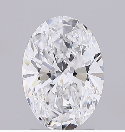 |  | US$2,295 | 97.2% |
My decision to include a stone in my recommendations is based on a measure combining a number of factors including:
- the AGS cut guidelines potential cut grade; What is AGS? See this article.
- how confident I am that the recipient will absolutely love love love the diamond;
- the value I believe it represents;
- how well it fits the brief.
My overall score (in the chart above) is a measure combining all those factors.
About Oval Cut Diamonds
Oval cuts have been quite a popular shape. Not only is it many people’s favorite shape, it’s a shape that is usually more affordable than round brilliant. Yes, it is easier on the pocketbook but you may have noticed that choosing an oval cut is not as straight forward nor is there as much information to aid with your choice as there is when choosing a round brilliant. For one, there’s no cut grade mentioned on an IGI diamond grading report issued for oval cut diamonds. Another thing you will notice immediately when looking at ovals online is that ovals do show their color more than round brilliants. F or higher is required if you want one of the “colorless” grades.
Let’s begin by getting to know the oval. After that we I’ll go over what to look for when choosing an oval.
Anatomy of an Oval Diamond
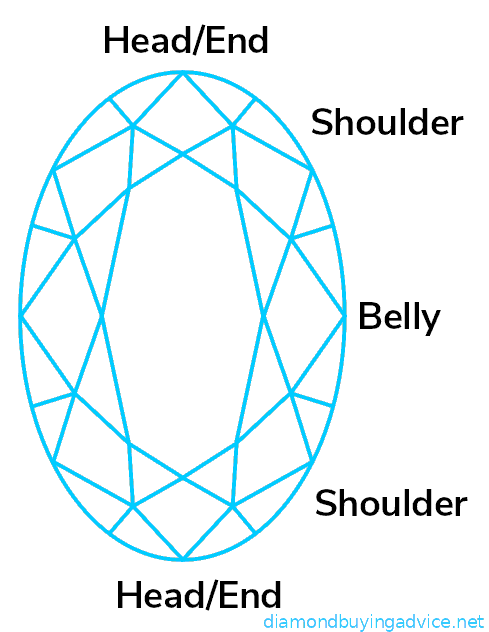
An oval diamond is a fancy shape. You can think of it as a round brilliant diamond stretched on its sides, or a rounded version of a cushion shape or cushion brilliant. To pick a beautiful oval diamond, you need to know its parts.
Head or end are the way we refer to the “tips” of an oval.
The shoulder is the curved area reaching from the head or end to the belly.
The belly is the central area where the sides curve out the most.
Facet Arrangement
You’ll mostly find that oval diamonds are cut in a style known as the “brilliant faceting” style. This means that the diamond has 57 or 58 facets, just as you would find in a standard round brilliant. So it looks a lot like a round brilliant in some ways. There are a few different ways the facets can be arranged in oval cut diamonds. The most common facet arrangement is where you have eight bezel facets on the crown and eight main facets on the pavilion. This arrangement works well to produce excellent brilliance and scintillation.
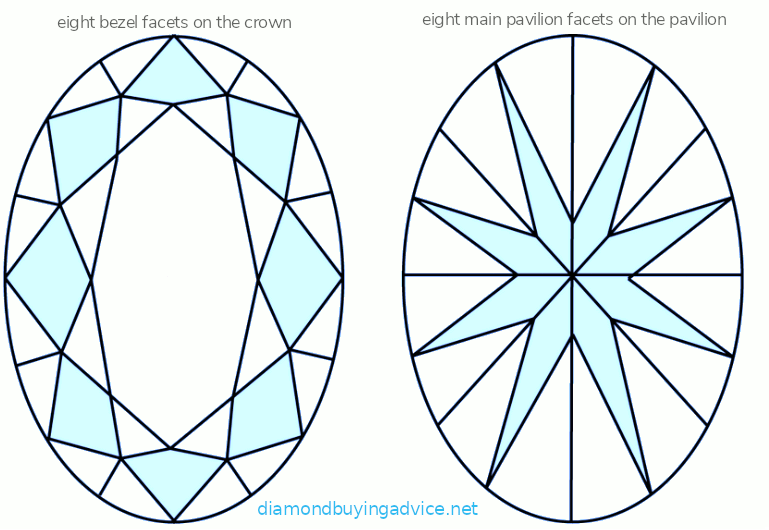
What to Look for when Choosing an Oval Cut Diamond
There are definite benefits to be had from buying an oval cut diamond: Since the oval diamond has a larger surface area than a round diamond of equal carat weight, it can appear larger to the eye. The oval shape can make the finger seem longer. And because the shape doesn’t have sharp angles or corners, an oval diamond is less prone to chipping compared to other fancy shapes.
Recommended Clarity For Oval Cut Diamonds
My primary motivation is to help you buy a diamond that you will be happy with. I’ve seen too many cases where someone thought they would save a few dollars by getting a Slightly Included diamond only to regret their decision. You are already saving money by buying online, so don’t ruin it by skimping out on one of the key factors that contributes to a diamond’s beauty! Clarity! Start with VS2 and then if you don’t find the size or color you want in the selection you are presented with then increase the clarity. That means go to VS1, and then VVS2. Yes VVS1 is usually overkill, but I think you’d rather have a beautiful stone that has value, then a stone you feel like taking a steel brush to every time you look at it! Even if you can’t see the inclusions in an SI1 or SI2 diamond it has a low clarity grade for a reason! It could be clouds, it could be tiny fractures, elegantly described on the diamond’s grading report as “twinning wisps” or the innocuous sounding “feathers”.
VS2 and above clarity is my recommendation. Very rarely do I endorse a diamond with an SI1 or worse clarity grade.
Length-to-Width Ratio
When looking at oval diamonds you have a number of length to width ratios to choose from. You may like a longer oval shape or you may prefer a chunkier oval. Very long ovals aren’t very common. At least not among natural diamonds. This is because it is not practical to cut overly long oval diamonds from the rough, so don’t be surprised if you don’t come across that many ovals with a length to width ratio of 1.7:1 or greater. You will find typical ovals have ratios between 1.3:1 and 1.4:1.
Symmetry
Symmetry is an important element contributing to the beauty and attractiveness of an oval cut diamond. Checking whether an oval diamond is symmetrical is very simple. Just trace an imaginary line down its center. The shape and faceting of the two halves should each be the same as each other. Do the same the other way, tracing an imaginary line across the middle of the oval. Do both sides look the same or is one part oddly misshapen?
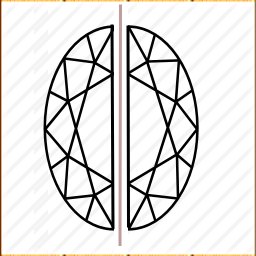
Check for symmetry
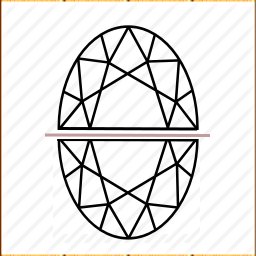
Do both halves look the same?
The Process I Use When Selecting Oval Cut Diamonds
— one of the reasons I get good reviews for my concierge service on TrustPilot
Oval diamonds, as the name implies, have an overall outline that is shaped like an ellipse rather than a circle.
Non-round shapes are known collectively as ‘fancy shape diamonds’ and the oval is certainly one of the most popular ‘fancy shapes. It is distinctive, bright, and its elongated shape is graceful on the finger.
The most common facet arrangement for oval diamonds is a brilliant configuration that is capable of producing excellent light performance (brilliance, fire and scintillation) if properly crafted.
Oval cut diamonds are sought after by anyone looking for something a little different, yet still has a lot or sparkle, is bright and showy.
The most common facet configuration is referred to as ‘oval brilliant’ on lab reports, and it looks very much like a round brilliant diamond that has been adjusted in length to accommodate the oval geometry.
The actual length to width ratio can vary significantly providing a range of choices depending on personal taste.
Some may prefer a rounder oval while others are attracted to a long slender shape. I often receive requests for ovals with a length to width ratio of 1.4. So this seems to be a l/w that a majority of people are after, though not everyone expresses a preference in regards to the length to width ratio.
The optics are similar to a round brilliant but oval cut diamonds have the advantage of being less expensive than rounds of similar size and quality.
Ovals are also versatile – perfectly lovely in solitaire styles as well as more ornate creations such as halo designs. They work particularly well as center stones in designs such as three-stone rings with oval diamond side stones, or with colored gemstones like ruby and sapphire which are most commonly cut in oval shapes.
Finding oval diamonds is relatively easy but actually choosing one requires some additional knowledge. It is one of the most popular ‘fancy cut’ diamonds but there are a number of complicating factors that make things a bit more challenging.
When shopping a lab certified diamond, you will know the weight, size, color and clarity and can compare those factors against other potential candidates on the basis of their lab reports.
But the most important value factor of any diamond is cut quality. This is where the diamond’s optics and light performance comes from.
All the facets work together in a dynamic system of tiny mirrors that reflect and refract light and return it to the eye, resulting in brightness, scintillation, and fire.
When shopping for an oval it is necessary to make other assessments beyond the information found on the diamond’s IGI report.
For a diamond to sparkle brilliantly, it must be cut well.
IGI does not provide an overall cut grade for any fancy cuts (only on round brilliants), making it difficult for a consumer to know if the diamond is crafted to a level that brings out its full optical potential, or whether light performance suffers as a result of cutting deficits.
The American Gem Society Laboratories (AGSL) does provide charts showing which numbers they use to grade ovals. You won’t find a wide selection of AGS graded oval cut diamonds on the market. This is because achieving an AGS “0”, which is the ideal (the highest grade) is extremely rare. The most one can expect is to find is an AGS cut grade of 1. So when I recommend a diamond I will check the AGS cut guidelines charts for each oval in question and make sure it has the potential to qualify at the very least as an AGS 1.
I assess oval cut diamonds videos for obvious signs of:
- CVD strain
- HPHT blue nuance and metallic flux remainder.
- overly thick or thin girdles
- prominent bow-tie effect
If a diamond girdle seems out of the ordinary I run a calculation to find out what the likely % of the girdle is. Anything thinner than 3% or thicker than 4.5% is rejected.
Further reading:
https://4cs.gia.edu/en-us/blog/allure-of-an-oval-diamond/
https://www.gia.edu/diamond-quality-factor
